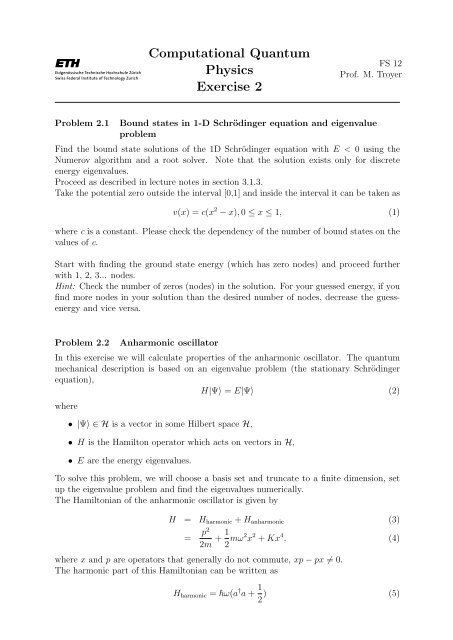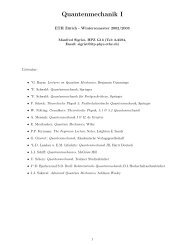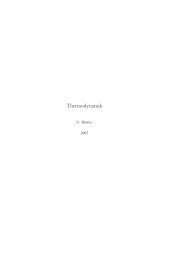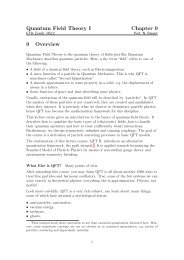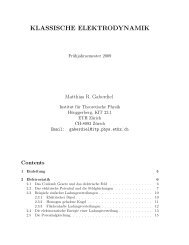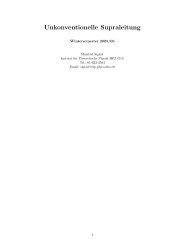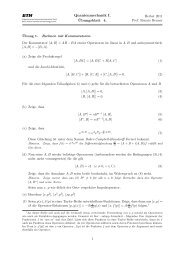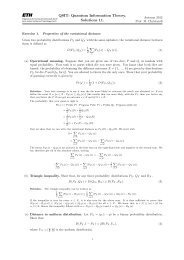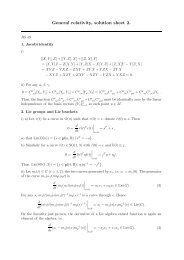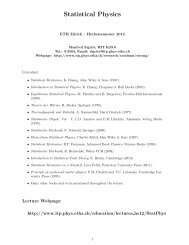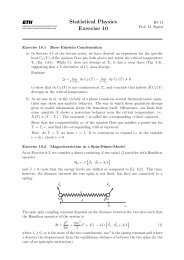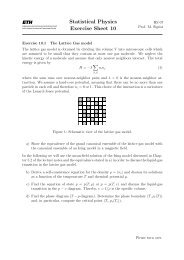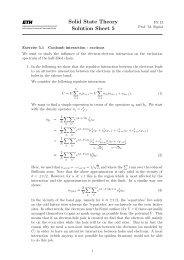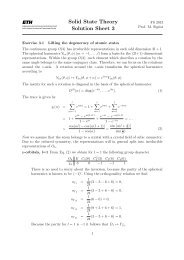Computational Quantum Physics Exercise 2
Computational Quantum Physics Exercise 2
Computational Quantum Physics Exercise 2
You also want an ePaper? Increase the reach of your titles
YUMPU automatically turns print PDFs into web optimized ePapers that Google loves.
<strong>Computational</strong> <strong>Quantum</strong><br />
<strong>Physics</strong><br />
<strong>Exercise</strong> 2<br />
FS 12<br />
Prof. M. Troyer<br />
Problem 2.1<br />
Bound states in 1-D Schrödinger equation and eigenvalue<br />
problem<br />
Find the bound state solutions of the 1D Schrödinger equation with E < 0 using the<br />
Numerov algorithm and a root solver. Note that the solution exists only for discrete<br />
energy eigenvalues.<br />
Proceed as described in lecture notes in section 3.1.3.<br />
Take the potential zero outside the interval [0,1] and inside the interval it can be taken as<br />
v(x) = c(x 2 − x), 0 ≤ x ≤ 1, (1)<br />
where c is a constant. Please check the dependency of the number of bound states on the<br />
values of c.<br />
Start with finding the ground state energy (which has zero nodes) and proceed further<br />
with 1, 2, 3... nodes.<br />
Hint: Check the number of zeros (nodes) in the solution. For your guessed energy, if you<br />
find more nodes in your solution than the desired number of nodes, decrease the guessenergy<br />
and vice versa.<br />
Problem 2.2<br />
Anharmonic oscillator<br />
In this exercise we will calculate properties of the anharmonic oscillator. The quantum<br />
mechanical description is based on an eigenvalue problem (the stationary Schrödinger<br />
equation),<br />
H|Ψ〉 = E|Ψ〉 (2)<br />
where<br />
• |Ψ〉 ∈ H is a vector in some Hilbert space H,<br />
• H is the Hamilton operator which acts on vectors in H,<br />
• E are the energy eigenvalues.<br />
To solve this problem, we will choose a basis set and truncate to a finite dimension, set<br />
up the eigenvalue problem and find the eigenvalues numerically.<br />
The Hamiltonian of the anharmonic oscillator is given by<br />
H = H harmonic + H anharmonic (3)<br />
= p2<br />
2m + 1 2 mω2 x 2 + Kx 4 , (4)<br />
where x and p are operators that generally do not commute, xp − px ≠ 0.<br />
The harmonic part of this Hamiltonian can be written as<br />
H harmonic = ω(a † a + 1 2 ) (5)
with the operators a and a † defined by<br />
√ mω<br />
a =<br />
2 x +<br />
√ mω<br />
a † =<br />
2 x −<br />
ip<br />
√<br />
2mω<br />
(6)<br />
ip<br />
√<br />
2mω<br />
, (7)<br />
where [a, a † ] = 1.<br />
The eigenstates |n〉 of the count operator N = a † a build a natural set of basis states for<br />
the harmonic oscillator. Their energy eigenvalues are given by 〈n|H harm |n〉 = ω(n + 1 2 ).<br />
We will use this as a basis set for the anharmonic oscillator, but truncate at a finite n.<br />
1. Using the definitions of a and a † , express the anharmonic part of the oscillator in<br />
second-quantized form.<br />
2. Calculate the non-vanishing matrix elements of H in the basis |n〉.<br />
3. Set up the matrix and diagonalize it numerically for finite n and small K.


